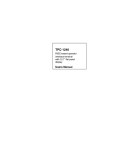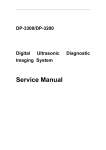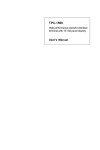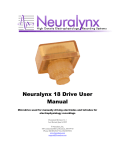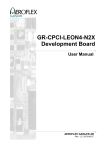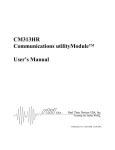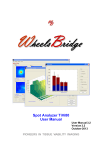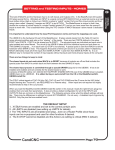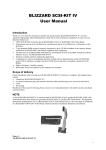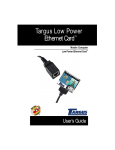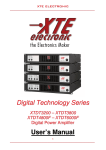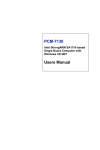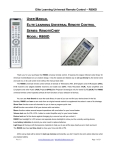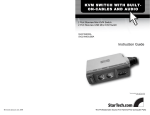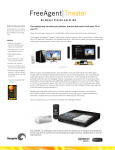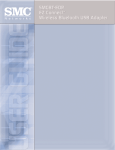Download TPC-1240
Transcript
TPC-1240 RISC-based operator interface terminal with 12.1” flat panel display User's Manual Copyright notice This document is copyrighted 2001 by Advantech Co., Ltd. All rights are reserved. Advantech Co., Ltd. reserves the right to make improvements to the products described in this manual at any time without notice. No part of this manual may be reproduced, copied, translated or transmitted in any form or by any means without the prior written permission of Advantech Co., Ltd. Information provided in this manual is intended to be accurate and reliable. However, Advantech Co., Ltd. assumes no responsibility for its use, nor for any infringements upon the rights of third parties which may result from its use. Acknowledgments TPC-1240 is a trademark of Advantech Co., Ltd. IBM, PC/AT, and PS/2 are trademarks of International Business Machines Corporation. MSDOS and Windows CE are trademarks of Microsoft Corporation. All other brand and product names mentioned herein are trademarks or registered trademarks of their respective holders. 1st edition August 2001 Packing List In the whole set of TPC-1240 there are items as listed below: 1.TPC-1240T-CE x 1 unit; the Windows CE operating system image is built in the flash memory on board. 2.Accessory kit which includes: (1) Panel mounting clamper x 8 pieces (2) Panel mounting screws x 8 pieces (3) 3-pin power connector x 1 piece (4) Support CD x 1 piece (5) 1 meter 9-pin to 9-pin null modem cable x 1 piece (6) Microsoft Windows CE end user license agreement x 1 piece FCC Class A This equipment has been tested and found to comply with the limits for a Class A digital device, pursuant to Part 15 of the FCC Rules. These limits are designed to provide reasonable protection against harmful interference when the equipment is operated in a commercial environment. This equipment generates, uses and can radiate radio frequency energy. If not installed and used in accordance with this user's manual, it may cause harmful interference to radio communications. Operation of this equipment in a residential area is likely to cause harmful interference, in which case the user will be required to correct the interference at his own expense. Safety Instructions 1. Read these safety instructions carefully. 2. Keep this installation reference guide for later reference. 3. Disconnect this equipment from any AC outlet before cleaning. Do not use liquid or spray detergents for cleaning. Use a damp cloth. 4. For pluggable equipment, the power outlet must be installed near the equipment and must be easily accessible. 5. Keep this equipment away from humidity. 6. Put this equipment on a reliable surface during installation. Dropping it or letting it fall could cause damage. 7. The openings on the enclosure are for air convection. Protect the equipment from overheating. DO NOT COVER THE OPENINGS. 8. Make sure the voltage of the power source is correct before connecting the equipment to the power outlet. 9. Position the power cord so that people cannot step on it. Do not place anything over the power cord. 10. All cautions and warnings on the equipment should be noted. 11. If the equipment is not used for a long time, disconnect it from the power source to avoid damage by transient over-voltage. 12. Never pour any liquid into an opening. This could cause fire or electrical shock. 13. Never open the equipment. For safety reasons, the equipment should be opened only by qualified service personnel. 14. If any of the following situations arises, get the equipment checked by service personnel: a. The power cord or plug is damaged. b. Liquid has penetrated into the equipment. c. The equipment has been exposed to moisture. d. The equipment does not work well, or you cannot get it to work according to the installation reference guide. e. The equipment has been dropped and damaged. f. The equipment has obvious signs of breakage. 15. DO NOT LEAVE THIS EQUIPMENT IN AN UNCONTROLLED ENVIRONMENT WHERE THE STORAGE TEMPERATURE IS BELOW 20° C (-4° F) OR ABOVE 60° C (140° F). IT MAY DAMAGE THE EQUIPMENT. The sound pressure level at the operator's position according to IEC 704-1:1982 is equal to or less than 70 dB(A). Wichtige Sicherheishinweise 1. Bitte lesen sie Sich diese Hinweise sorgfältig durch. 2. Heben Sie diese Anleitung für den späteren Gebrauch auf. 3. Vor jedem Reinigen ist das Gerät vom Stromnetz zu trennen. Verwenden Sie Keine Flüssig-oder Aerosolreiniger. Am besten dient ein angefeuchtetes Tuch zur Reinigung. 4. Die NetzanschluBsteckdose soll nahe dem Gerät angebracht und leicht zugänglich sein. 5. Das Gerät ist vor Feuchtigkeit zu schützen. 6. Bei der Aufstellung des Gerätes ist auf sicheren Stand zu achten. Ein Kippen oder Fallen könnte Verletzungen hervorrufen. 7. Die Belüftungsöffnungen dienen zur Luftzirkulation die das Gerät vor überhitzung schützt. Sorgen Sie dafür, daB diese Öffnungen nicht abgedeckt werden. 8. Beachten Sie beim AnschluB an das Stromnetz die AnschluBwerte. 9. Verlegen Sie die NetzanschluBleitung so, daB niemand darüber fallen kann. Es sollte auch nichts auf der Leitung abgestellt werden. 10. Alle Hinweise und Warnungen die sich am Geräten befinden sind zu beachten. 11. Wird das Gerät über einen längeren Zeitraum nicht benutzt, sollten Sie es vom Stromnetz trennen. Somit wird im Falle einer Überspannung eine Beschädigung vermieden. 12. Durch die Lüftungsöffnungen dürfen niemals Gegenstände oder Flüssigkeiten in das Gerät gelangen. Dies könnte einen Brand bzw. elektrischen Schlag auslösen. 13. Öffnen Sie niemals das Gerät. Das Gerät darf aus Gründen der elektrischen Sicherheit nur von authorisiertem Servicepersonal geöffnet werden. 14. Wenn folgende Situationen auftreten ist das Gerät vom Stromnetz zu trennen und von einer qualifizierten Servicestelle zu überprüfen: a. Netzkabel oder Netzstecker sind beschädigt. b. Flüssigkeit ist in das Gerät eingedrungen. c. Das Gerät war Feuchtigkeit ausgesetzt. d. Wenn das Gerät nicht der Bedienungsanleitung entsprechend funktioniert oder Sie mit Hilfe dieser Anleitung keine Verbesserung erzielen. e. Das Gerät ist gefallen und/oder das Gehäuse ist beschädigt. f. Wenn das Gerät deutliche Anzeichen eines Defektes aufweist. 15. Bitte lassen Sie das Gerät nicht unbehehrt hinten unter -20° C (-4° F) oder oben 60° C (140° F), weil diesen Temperaturen das Gerät zerstören könten. Der arbeitsplatzbezogene Schalldruckpegel nach DIN 45 635 Teil 1000 beträgt 70dB(A) oder weiger. DISCLAIMER: This set of instructions is provided according to IEC704-1. Advantech disclaims all responsibility for the accuracy of any statements contained therein. CHAPTER 1 General Information This chapter gives background information on the TPC-1240. Sections include: • Introduction • Specifications • LCD Specifications • Touchscreen specifications • Power • I/O ports • Mounting • Exploded diagram • Dimensions and cutout 1.1 Introduction The TPC-1240 touch panel computer is an excellent product for HMI (Human Machine Interface). This 12.1” display operator interface is a RISC-based platform with these key features: - All in on platform: the CPU, DRAM and Windows CE are integrated. The Windows CE 3.0 inside provides real-time control, ActiveX controls, OPC (OLE for Process Control), etc. With the SDK Advan tech provides users can easily build (or re-build) application pro grams by well known Visual C++ or Visual Basic languages. - Slim but robust: the TPC-1240 is very thin (50mm thickness) and lightweight (2.2 kg). This makes it the best solution for those applica tions that are tough in space or weak structural support. - Cost effective: applying a high brightness TFT LCD with SVGA resolution (800x600). The TPC-1240 offers cost effective solution for operator interface terminals. With proper application programs it would give a comfortable graphic user interface (GUI) at this size of display. - Fan-less and modular CPU board: the introduction of low power processor prevents this system from unreliable fans. In addition, the modular design facilitates the maintenance or possible upgrade on the CPU board. - Powerful communication capability: the TPC-1240 provides serial ports and Ethernet communication. These two means of communica tion are the most welcomed ones in the field of industrial automation. - Windows CE support: Advantech provides platform support for Windows CE. The operating system is built-in, the SDK for userdefined application programs are freely offered. 1.2 Specifications 1.2.1 System kernel (CPC-1110) - CPU: Intel StrongARMTM SA1110 RISC processor - BIOS: there is no BIOS in RISC platform; similar functions are built on board directly 2 TPC-1240 User's Manual - VGA: MediaQ MQ200 VGA controller - DRAM: built-in 32 MB SDRAM - Ethernet: SMSC LAN91C96I 10Base-T Ethernet controller - Watchdog timer: Dallas DS1670 watchdog timer; 0.25, 0.5 and 1 second timeout period programmable - Floppy diskette: the TPC-1240 does not provide floppy disk interface 1.2.2 I/O ports - 3 serial ports: 9-pin RS-232 (COM1), RS-485 (COM2) and 2-pin RS232(COM3) - 1 RJ-45 Ethernet port 1.2.3 Storage - The primary storage device is the 16MB built-in flash memory (flashROM). The default Windows CE operating system is in this device. - The TPC-1240 provides one CompactFlash card slot. This slot is for the storage of variety of Windows CE-based application programs. 1.2.4 Safety and environment Safety - FCC class A and CE certificated - BSMI certificated - The front bezel is compliant with NEMA 4/IP65 Environment - Operating temperature: 0~50° Celsius - Storage temperature: -20~60° Celsius - Humidity: 10~95% @ 40° Celsius relative humidity (non-condensing) Chapter 1 General Information 3 - Vibration: 10~18 Hz: 1.5mm peak-to-peak displacement; 18~500 Hz: 1G acceleration 1.3 LCD specifications Dis play Type TFT color LCD Size (Diagonal) 12.1" M aximum Re s olution 800 x 600 (SVGA) M aximum Colors 256K Pixe l pitch (WxH, mm) 0.31 x 0.31 Vie wing angle 100 Luminance (cd/m ) 300 Contras t ratio 150 minimum 2 Ope rating te mpe rature ( C) 0- 50 (ambient) VR control Brightness Backlight 2 C C FL Backlight M TTF 50,000 hours o Table 1.3-1 LCD specifications Notice: 4 There might be several bright or dark pixels on the LCD. This comes from the production of the LCD. Such phenomenon is claimed to be normal according to the LCD manufacturers. TPC-1240 User's Manual 1.4 Touchscreen specifications Type Resistive Bas e glas s cons truction Tempered Glass Re s olution Continuous Light trans mis s ion 75% typical Controlle r PS/2 interface Powe r rating 3.3 to 5 V Software drive r Windows CE (embedded) Durability 100 million touches DC Table 1.4-1 Touchscreen specifications 1.5 Power The TPC-1240 works by 24VDC power input. The maximum current is about 0.8A, and the nominal power consumption is 20 watts. Despite the input voltage rating, the TPC-1240 can operate by 18~30VDC. Chapter 1 General Information 5 1.6 I/O ports arrangement The TPC-1240 has 3 serial ports, 1 RJ-45 LAN port. The arrangement of these ports is shown in Figure 1.6-1. Figure 1.6-1 I/O ports arrangement 1.7 Mounting 1.7.1 Panel mounting 1.There is a piece of adhesive waterproof gasket on the plastic front bezel. Make sure the waterproof gasket is in position before install the TPC-1240 to the panel opening. 2.Install the TPC-1240 to the panel opening. 3.Find out the eight clampers and eight long screws in the accessory pack.Hook those clampers to those holes around the four sides of the bezel. Insert the screws to every clamper and fasten them. These screws will then push on the mounting panel and fix the unit. 4.The mounting panel thickness is suggested to be less than 6mm (0.236 inch). Figure 1.7-1Panel mounting 6 TPC-1240 User's Manual 1.8 Exploded diagram Figure 1.8-1Exploded diagram Chapter 1 General Information 7 1.9 Dimensions and cutout - Weight: 2.2 kg (without HDD) - Dimension: 311 x 237 x 50mm (WxHxD) - Cutout: 302 x 228mm (suggested) Figure 1.9-1Dimensions and cutout 8 TPC-1240 User's Manual CHAPTER 2 System Quick Starting This chapter provides a brief explanation for fast starting the TPC-1240 Step 1 Unpack the TPC-1240 from its packaging. Please check the packing list at the beginning of this manual. Cushion (P/N:2130201590 ) Accessory Box (P/N: 2110002150) Gift Box (P/N: 2110002430) Figure 2-1 Unpack the unit Step 2 Insert a CompactFlash memory card containing other Windows CEbased application program. Please refer to section 4.4 for building Windows CE applications for the TPC-1240. Warning: Step 3 10 Though the CompactFlash memory card is supposed to be hot swappable, it is recommended you turn off system power before installing the memory card. Thus, potential data loss can be avoided. Connect the power connector to a 24VDC power source. The power source can either be from a power adapter or an in-house power source. TPC-1240 User's Manual Figure 2-2 Power connector and power lines Warning: Step 4 If the power source is not connected to the correct pins, the system may be damagedwhen the power is turned on. Plug the power source to the system power supply. Figure 2-3 Power connector pin assignment Chapter 2 Quick Start Guide 11 Step 5 Turn on the system power switch. Figure 2-4 Plug the power lines to the system power supply. Step 6: 12 Calibrate the touchscreen. Detialed procedures are de scribed in section 5.2. TPC-1240 User's Manual CHAPTER 3 The Engine of the TPC-1240 This chapter briefly introduces the CPU board and the I/O board which comprise the system. 3.1 Introduction The engine of the TPC-1240 is constructed by the combination of two PCBA—one main board and one I/O board. Such combination makes system customization feasible. 3.2 CPC-1110 main board Description J1 TPC- 1240 LCD control bus Table 3.2-1 CPC-1110 main board connector/jumper list 3.2.1 Connector pin assingments Pin Signal Pin Signal 1 #CAS1 11 #CAS2 2 #CAS3 12 DCK0 3 DCK1 13 CKE0 4 CKE1 14 DCK2 5 #SDCS3 15 #SDCS2 6 #SDCS1 16 JTAG_TCK 7 #SDCS0 17 JTAG_TDI 8 #SDRAS 18 JTAG_TMS 9 #SDCAS 19 JTAGTDO 10 #CAS0 20 #JTAGTRST Table 3.2-2 LCD control bus pin assignment 14 TPC-1240 User's Manual 3.3 TPC-1240 I/O Board Description CN2 50-pin FPC connector CN3 144-pin SODIMM connector CN4 20-pin FPC connector CN6/CN7 PS/2 keyboard and mouse connector CN8 Ethernet 10Base-T RJ-45 connector CN9 Power DC input connector CN10/CN12 COM1/COM3 RS-232 ports CN11 COM2 RS-485 serial Port (auto data flow control by Windows CE) CN14 LCD connector CN15 VGA connector CN17 LCD inverter connector CN18 CompactFlashTM socket 50-pin connector JP200/JP201 Touchscreen interface connectors Table 3.3-1 TPC-1240 I/O board connector/jumper list COM1 (9-pin RS-232) COM3 (2-pin RS-232) Pin Signal Pin Signal 1 DCD 1 N/C 2 RXD 2 RXD 3 TXD 3 TXD 4 DTR 4 N/C 5 GND 5 GND 6 DSR 6 N/C 7 RTS 7 N/C 8 CTS 8 N/C 9 RI 9 N/C Table 3.3-2 TPC-1240 COM1/COM3 (RS-232) serial ports Chapter 3 The Engine of the TPC-642 15 Pin Signal 1 DATA- 2 DATA+ 3 N/C (TX232) 4 N/C (RX232) 5 GND 6 N/C 7 N/C 8 N/C 9 N/C Table 3.3-3 TPC-1240 COM2 (auto flow control RS-485) serial port Pin Signal 1 12V 2 GND 3 ENABKL 4 VBR 5 N/C Table 3.3-4 LCD inverter connector Pin Signal 1 24VDC(+) 2 24VDC(-) 3 GND Table 3.3-5 Power Connector 16 TPC-1240 User's Manual Pin Signal Pin Signal 1 VDDSAFE5 2 VDDSAFE5 3 GND 4 GND 5 VDDSAFE3 6 VDDSAFE3 7 Vcon 8 GND 9 LCD_D0 10 LCD_D1 11 LCD_D2 12 LCD_D3 13 LCD_D4 14 LCD_D5 15 LCD_D6 16 LCD_D7 17 LCD_D8 18 LCD_D9 19 LCD_D10 20 LCD_D11 21 LCD_D12 22 LCD_D13 23 LCD_D14 24 LCD_D15 25 N/C 26 N/C 27 N/C 28 N/C 29 N/C 30 N/C 31 N/C 32 N/C 33 GND 34 GND 35 SHCLK 36 FLM 37 M/DE 38 LP 39 ENABKL 40 ENAVEE Table 3.3-6 16-bit LCD display connector Chapter 3 The Engine of the TPC-642 17 Pin Signal 1 SENSE_XL 2 SENSE_XR 3 SENSE_YT 4 SENSE_YB Table 3.3-7 Touchscreen interface connector 18 TPC-1240 User's Manual CHAPTER 4 Windows CE in the TPC-1240 4.1 Introduction The TPC-1240 operator interface terminal is designed to serve on the Windows CE platform. The Windows CE is a compact operating system that occupies less storage space or system resources compared with other operating systems. By its modular nature, it is possible to choose those functions that are useful for specific application. Not only reducing the system resources required, it also reduces start-up time. In the field of industrial automation or for operator interface terminal, this is an appealing feature because the impact of downtime would be minimized. Furthermore, the small storage space it needs makes operating system on solid-state disk possible. Figure 4.1-1 Windows CE on TPC-642 4.2 TPC-1240 utilities There are several useful utilities built in the standard Windows CE OS of the TPC-1240: 4.2.1 Soft-keyboard The TPC-1240 is dedicated as an operator interface. A software keyboard is embedded in the standard TPC-1240 OS. Upon boot-up, a small keyboard icon would appear on the status bar. Tap this icon by the stylus to activate/hide this Soft-keyboard. 20 TPC-1240 User's Manual Figure 4.2-1 Soft-keyboard 4.2.2 Screen saver From time to time it is unnecessary to turn on the TPC-1240 display all the day. The TPC-1240 Windows CE OS provides a utility to turn off theLCD and backlight, and thus elongates the display repair period. When the system finishes boot-up a small icon “S” appears on the status bar. Tap this icon by a stylus the setting window pops out. Chapter 4 Windows CE in the TPC-642 21 Figure 4.2-2 Screen saver setting When the screen saver setting is done, tap “OK” to accept the settings just made, “Cancel” to discard or “Save” to permanently save the settings to the registry. Notice: 4.2.3 Please be careful when selecting “Save”. This command will overwrite all registry data—not only the screen saving settings. Watchdog timer It is important in industrial applications that the control systems are rarely down, or are capable of self-reset if they are halted somehow. The watchdog timer is therefore used in the TPC-1240 to provide automatic reset. There is a timer inside the watchdog timer. The TPC1240 should clear the timer within a pre-set time interval periodically. If the timer is not cleared, the timer would assume the system to be halted and generate a reset. The watchdog timer in the TPC-1240 provides three different time intervals: 0.2 second, 0.5 second and 1.0 second. As mentioned in the section 4.2.2: when the system boots, there is an icon “S” on the status bar. Tap this icon by a stylus for the setting window. 22 TPC-1240 User's Manual Figure 4.2-3 Watchdog timer setting Select whichever time interval required, and tap one of the buttons: “OK”, “Cancel” or “Save”. Notice: 4.2.4 Please be careful before selecting “Save”. This command will overwrite all registry data—not only the watchdog timer settings. Saving registry The TPC-1240 builds and bundles its Windows CE OS in the on-board flash memory, and provides a CompactFlash slot for various applications. It is possible for users to save specific registry settings on the CompactFlash memory cards (together with the application programs) or in the on-board flash memory (together with the machine). The utility “Regflash” is a convenient tool to save or overwrite registry data. From the Windows CE status bar, tap “Start/Run”. Use the soft-keyboard to type “regflash” command in the command text box and press “OK”. Chapter 4 Windows CE in the TPC-642 23 Figure 4.2-4 Regflash Notice: Please be careful before using this utility “Regflash”. This command will overwrite all registry data. Figure 4.2-5 Regflash commands 24 TPC-1240 User's Manual 4.3 4.3.1 Networking Networking via Ethernet The TPC-1240 is equipped with a 10Base-T Ethernet controller. To utilize it, change the device name when the TPC-1240 is first turned on. Step 1: Click “Start/Settings/Control Panel” Figure 4.3-1 Control Panel Step 2: Double click “Communications” Step 3: Find the default device name. Change it to a unique one depending on the plan of individual LANs. Step 4: Use the command “Regsave” or the utility “Regflash” mentioned in section 4.2.4 to save this changed name Step 5: If the TPC-1240 is a node of a LAN with DHCP servers, it is now available. Step 6: If the TPC-1240 is a node of a LAN with fixed IP server, please consult with MIS to get specific IP address. Click “Start/Settings/Control Panel”. Double click “Network” and update the IP address. Step 7: Use the command “Regsave” or the utility “Regflash” to save this changed name. Chapter 4 Windows CE in the TPC-642 25 Figure 4.3-2: Neworking by Windows Explorer 4.3.2 Networking via serial port The TPC-1240 with built-in Windows CE supports serial connection to host computers. The host computer must install the Microsoft ActiveSync service offered by Microsoft. Use a null modem cable bundled with the TPC-1240 to connect the serial ports of the host computer and the TPC-1240. Then activate ActiveSync service on the host computer. The host will automatically scan its serial ports and make a connection. 26 Step 1: Make sure the Microsoft ActiveSynce service and the Microsoft embedded Visual Tools are properly installed in the host PC. Step 2: Connect the two RS-232 ports of the host PC and the TPC1240 by a null modem cable. Step 3: If users are using the Microsoft eMbedded Visual Tools to develop Windows CE application runtimes, make sure the TPC-1240 SDK provided in the TPC-1240 support CD is also properly installed in the host PC. TPC-1240 User's Manual Step 4: Click "Start/Programs/Communication/Remote Networking" Figure 4.3-3 Remote networking Step 5: Make a new connection. As the dialogue box pops out, choose the default "Direct Connection". Figure 4.3-4 Make new connection Chapter 4 Windows CE in the TPC-642 27 Figure 4.3-5 Direct connection Step 6: Click "Next" and "Finish" to complete making new connec tion. It is recommended to keep the default settings of the serial ports connection. Figure 4.3-6 Default settings 28 TPC-1240 User's Manual Figure 4.3-7 Default settings (continued) Step 7: If the ActiveSync service on the host PC has been activat ed, the above six steps will make the TPC-1240 automatical ly try to connect the host. Notice: Connection by ActiveSync may be sophisticated. Check Microsoft web site or local Microsoft service specialists if necessary. 4.3.3 Web browser The TPC-1240 built-in Windows CE OS includes Microsoft Pocket IE. It can be used to browse web pages on World Wide Web via LAN or dial-up connection. 4.4 Application program development The TPC-1240 is bundled with built-in Windows CE operating system. In real applications users need to execute various application programs on it. However, unlike its other family the Windows CE is a hardwaredependent operating system. That is to say, Windows CE application programs are only portable in the source code level. Users must rebuild the runtime file for a different Windows CE platform even though the source code may not be changed at all. Chapter 4 Windows CE in the TPC-642 29 4.4.1 System requirements - Intel Pentium-90 CPU or more advanced - Microsoft Windows 2000 Professional or Windows NT Workstation 4.0 - Microsoft eMbedded Visual Tools 3.0 - Platform SDK for TPC-1240 (bundled in the standard TPC-1240T-CE) - 64MB DRAM - CD-ROM drive - Monitor with VGA resolution at least - Mouse - 200MB free hard disk space at least - Connection to the same LAN as the TPC-1240 if LAN is used for development TPC-1240 - TPC-1240T-CE - Connection to the same LAN as the host PC if LAN is used for development - Null modem cable (bundled in the standard TPC-1240T-CE) 4.4.2 Building Windows CE runtime By the platform SDK bundled with the standard TPC-1240, users can build the Windows CE runtime by the eMbedded Visual Tools. User-defined AP source code TPC-1240 SDK Microsoft eMbedded Visual Tools AP runtime for TPC-1240 Figure 4.4-1 Flow-chart of building Windows CE runtime 30 TPC-1240 User's Manual CHAPTER 5 System Tuning It is necessary to tune system settings from the defaults. The most common ones are included in this chapter. 5.1 LCD brightness tuning The display brightness of the TPC-1240 is designed to be adjustable. There is an access opening at the rear case of this machine. Use a blade screwdriver to reach the variant resistor inside, and adjust the contrast to satisfactory level. Figure 5.1-1 Adjust LCD brightness 5.2 Touchscreen calibration The touchscreen calibration utility program is built in the Windows CE: Step 1: From the Windows CE status bar, click “Start/Programs” Figure 5.2-1 Start/Programs 32 TPC-642 User's Manual Step 2: Double-click “Windows Explorer” Figure 5.2-2 Windows Explorer Step 3: Double-click “Control Panel” Figure 5.2-3Control Panel Chapter 5 System Tune Up 33 Step 4: In the Control Panel window find the "Touchscreen" icon and double-click it. Step 5: The calibration window pops out. Click the "Calibrate" button. Figure 5.2-4 Calibration Step 6: A calibration screen appears. Click the circle by a stylus or a finger. Figure 5.2-5 Calibration screen (1) Step 7: 34 The second calibration screen appears. Click the circle again. TPC-642 User's Manual Figure 5.2-6 Calibration screen (2) Step 8: Click "OK" to save the calibration results. Figure 5.2-7 Calibration screen Chapter 5 System Tune Up 35 36 TPC-642 User's Manual CHAPTER 6 Maintenance In practice, users may need on site maintenance. This chapter covers several simple repairings that can be done by qualified technicians. The TPC-1240 is designed to be modular, slim and lightweight for easier maintenance. The following sections are dedicated to describe how a qualified technician can replace major components. 6.1 CPU board replacement Step 1: Remove the screw on the CPU board cover. Step 2: Slide the CPU board cover toward the opposite side of the I/O ports. Figure 6.1-1 CPU board cover Step 3: Take away the CPU board cover. Figure 6.1-2 Remove the CPU board cover 38 TPC-642 User's Manual Step 4: The CPU board is now visible. It connects to the I/O board by a 144-pin SO-DIMM connector and a 20-pin FPC connector. Step 5: Use a pair of tweezers to loosen the 20-pin FPC connector, and release the FPC. Step 6: Bend outward the two metal latches of the SO-DIMM connec tor by thumbs. The free end of the CPU board would swing up. Pull out the CPU board. Figure 6.1-3 Remove the CPU board Step 7: Insert a new CPU board to the SO-DIMM connector. Step 8: Push down and lock the CPU board. Step 9: Use a pair of tweezers to insert the 20-pin FPC to the connector on the CPU board. Then tighten the connector. Step 10: Replace the CPU board cover and fasten the screw. 6.2 Fuse replacement Step 1: Remove the fuse cover. Step 2: Replace the damaged fuse with a new one. Chapter 1 General Information 39 Step 3: Replace the fuse cover. Figure 6.2-1 Replace the fuse Warning: 40 1. Do not replace the fuse unless it is damaged. 2. Do not replace the fuse with a different rating. TPC-642 User's Manual APPENDIX A Fuse Specifications A.1 Fuse Specifications The fuse used on the TPC-1240 is: Rating: 250VAC, 5Amp. Size: 5 x 20mm 42 TPC-642 User's Manual APPENDIX B Registry searching sequence of the TPC-1240 B.1 Registry searching sequence of TPC1240 When the TPC-1240 is turned on, the Windows CE will search for registry to load those important system parameters. There are three alternatives to save the registry: registry file on the external CompactFlash memory card, registry file on the built-in flash memory or default registry settings in the Windows CE image file. Figure.B.1-1 shows how TPC-1240 searches for the registry. Power On Search registry file on CompactFlash card Registry file on CF? Y N N Search registry file on builton flashROM Load CF registry Registry file on flashROM? A Y Load default registry from Windows CE image Y A FlashROM registry disable? A N Load flashROM registry The rest of bootup procedure Figure B.1-1 Flow-chart of building Windows CE runtime 44 TPC-1240 User's Manual


















































